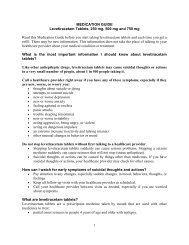Form 6-K - Dr. Reddy's
Form 6-K - Dr. Reddy's
Form 6-K - Dr. Reddy's
Create successful ePaper yourself
Turn your PDF publications into a flip-book with our unique Google optimized e-Paper software.
DR. REDDY’S LABORATORIES LIMITED AND SUBSIDIARIES<br />
UNAUDITED CONDENSED CONSOLIDATED INTERIM FINANCIAL STATEMENTS<br />
(in thousands, except share and per share data)<br />
4. Explanation of transition to IFRS (continued)<br />
c. Reconciliations (continued)<br />
The aforesaid differences have resulted in a decrease of profit under IFRS by Rs.25,490 for the year ended March 31, 2008.<br />
D. Fringe benefit tax on employee share based payments<br />
Indian tax regulations require the Company to pay a Fringe Benefit Tax upon the exercise of employee stock options. Under Previous<br />
GAAP, Fringe Benefit Tax is accrued upon the exercise of stock options. Under IFRS such Fringe Benefit Tax, if not recovered from<br />
employees, are accrued over the vesting period of the stock options. In the event, the Company decides to recover the related Fringe<br />
Benefit Tax from the employees exercising such options a reimbursement asset is recognized in the same period which offsets the<br />
accrual for the Fringe Benefit Tax.<br />
The aforesaid differences have resulted in a decrease in equity under IFRS by Rs.61,147 and Rs.52,946 as of June 30, 2008 and<br />
March 31, 2008, respectively, and a decrease of profit under IFRS by Rs.61,147 and Rs.52,946 for the three months ended June 30,<br />
2007 and the year ended March 31, 2008, respectively.<br />
E. Tax adjustments<br />
Intra-group transactions are eliminated upon consolidation. Under Previous GAAP, income taxes paid by the seller on intra-group<br />
profits in respect of assets that remain within the consolidated group, including the tax effect of any reversing temporary differences<br />
in the seller’s tax jurisdiction, are deferred. The amount is recognized in other assets or liabilities in the balance sheet until such time<br />
as the asset leaves the consolidated group, at which point the amount is reclassified to income tax expense. Under IFRS, any related<br />
deferred tax effects are measured based upon the tax rate of the purchaser. However, the tax effects are not eliminated unless the<br />
transacting entities are subject to the same tax rate.<br />
Furthermore, the income tax expense recognized in each interim period under Previous GAAP is based on the best estimate of the<br />
weighted average effective income tax rate expected for the annual reporting period applied to the pre-tax income of the interim<br />
period. Under Previous GAAP, a consolidated Annual Effective Tax Rate is arrived at based upon projected tax expense and profit<br />
before taxes for each of the tax jurisdictions and then such consolidated Annual Effective Tax Rate is applied to consolidated profits<br />
for the quarter. Under IFRS, if different income tax rates apply to different tax jurisdictions, income tax expense is computed by<br />
applying the projected Annual Effective Tax Rate for each of the jurisdictions on the pre-tax income of the interim period for each of<br />
such jurisdictions, respectively.<br />
The above differences in IFRS as compared to Previous GAAP, along with the tax impact of the adjustments as discussed above,<br />
have resulted in an increase in equity by Rs.453,957, Rs.313,711 and Rs.169,508 as of April 1, 2007, June 30, 2007 and March 31,<br />
2008, respectively, and a decrease in profit by Rs.140,246 and Rs.257,015 for the three months ended June 30, 2007 and the year<br />
ended March 31, 2008, respectively.<br />
F. Change in presentation of minority interest<br />
Under IFRS, minority interest is reported as a separate item within equity. Previous GAAP requires minority interest to be presented<br />
separately from equity. Under IFRS, the minority’s share of net income is presented as an allocation of net income, whereas, under<br />
Previous GAAP, the minority’s share of net income is considered in determining net income.<br />
The aforesaid differences have resulted in an increase of equity under IFRS by Rs.10,473 and Rs.7,450 as of April 1, 2007 and<br />
June 30, 2007, respectively, and a decrease of profit under IFRS by Rs.3,023 and Rs.10,473 for the three months ended June 30, 2007<br />
and the year ended March 31, 2008, respectively.<br />
iv. Explanation of material adjustments to the cash flow statement<br />
Unlike Previous GAAP, under IFRS while bank overdrafts are disclosed as part of borrowings in the balance sheet, the same are<br />
reduced from cash and cash equivalents in preparation of the cash flows if they are repayable on demand and form an integral part of<br />
the Company’s cash management. There were bank overdrafts of Rs.526,030 as at April 1, 2007 and Rs.434,928 as at March 31,<br />
2008 that were repayable on demand, and which formed an integral part of the Company’s cash management and were not<br />
considered as a reduction in cash and cash equivalents. Accordingly,<br />
26




